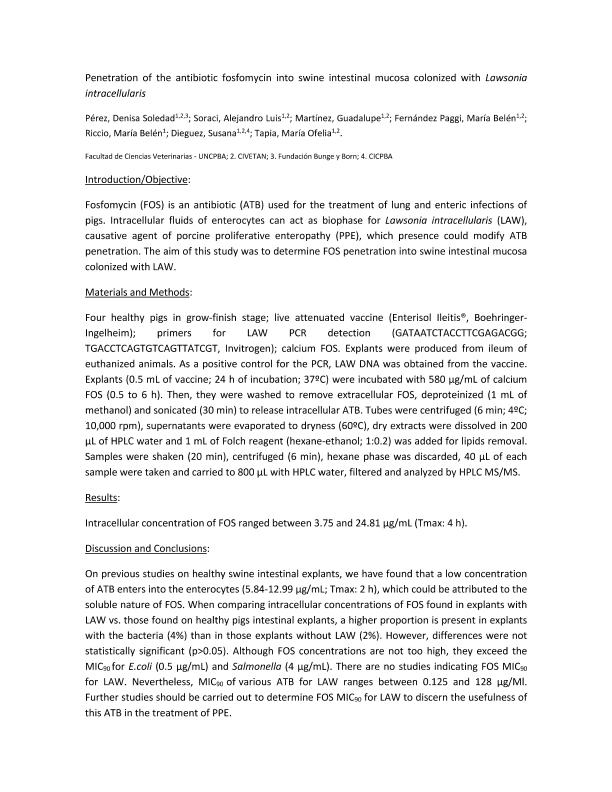Mostrar el registro sencillo del ítem
dc.contributor.author
Pérez, Denisa Soledad

dc.contributor.author
Martínez, Guadalupe

dc.contributor.author
Fernández Paggi, María Belén

dc.contributor.author
Decundo, Julieta María

dc.contributor.author
Romanelli, Agustina

dc.contributor.author
Dieguez, Susana Nelly

dc.contributor.author
Soraci, Alejandro Luis

dc.date.available
2018-08-06T15:54:36Z
dc.date.issued
2018-07
dc.identifier.citation
Pérez, Denisa Soledad; Martínez, Guadalupe; Fernández Paggi, María Belén; Decundo, Julieta María; Romanelli, Agustina; et al.; Ex vivo penetration of fosfomycin into healthy and Lawsonia intracellularis- colonized swine intestinal mucosa; Wiley Blackwell Publishing, Inc; Journal of Veterinary Pharmacology and Therapeutics; 38; S1; 7-2018; 94-94
dc.identifier.issn
0140-7783
dc.identifier.uri
http://hdl.handle.net/11336/54253
dc.description.abstract
Fosfomycin (FOS) is an antibiotic (ATB) used for the treatment of lung and enteric infections of pigs. Intracellular fluids of enterocytes can act as biophase for Lawsonia intracellularis (LAW), causative agent of porcine proliferative enteropathy (PPE), which presence could modify ATB penetration. The aim of this study was to determine FOS penetration into swine intestinal mucosa colonized with LAW.Four healthy pigs in grow-finish stage; live attenuated vaccine (Enterisol Ileitis®, Boehringer-Ingelheim); primers for LAW PCR detection (GATAATCTACCTTCGAGACGG; TGACCTCAGTGTCAGTTATCGT, Invitrogen); calcium FOS. Explants were produced from ileum of euthanized animals. As a positive control for the PCR, LAW DNA was obtained from the vaccine. Explants (0.5 mL of vaccine; 24 h of incubation; 37ºC) were incubated with 580 µg/mL of calcium FOS (0.5 to 6 h). Then, they were washed to remove extracellular FOS, deproteinized (1 mL of methanol) and sonicated (30 min) to release intracellular ATB. Tubes were centrifuged (6 min; 4ºC; 10,000 rpm), supernatants were evaporated to dryness (60ºC), dry extracts were dissolved in 200 µL of HPLC water and 1 mL of Folch reagent (hexane-ethanol; 1:0.2) was added for lipids removal. Samples were shaken (20 min), centrifuged (6 min), hexane phase was discarded, 40 µL of each sample were taken and carried to 800 µL with HPLC water, filtered and analyzed by HPLC MS/MS. Intracellular concentration of FOS ranged between 3.75 and 24.81 µg/mL (Tmax: 4 h).On previous studies on healthy swine intestinal explants, we have found that a low concentration of ATB enters into the enterocytes (5.84-12.99 μg/mL; Tmax: 2 h), which could be attributed to the soluble nature of FOS. When comparing intracellular concentrations of FOS found in explants with LAW vs. those found on healthy pigs intestinal explants, a higher proportion is present in explants with the bacteria (4%) than in those explants without LAW (2%). However, differences were not statistically significant (p>0.05). Although FOS concentrations are not too high, they exceed the MIC90 for E.coli (0.5 µg/mL) and Salmonella (4 µg/mL). There are no studies indicating FOS MIC90 for LAW. Nevertheless, MIC90 of various ATB for LAW ranges between 0.125 and 128 µg/Ml. Further studies should be carried out to determine FOS MIC90 for LAW to discern the usefulness of this ATB in the treatment of PPE.
dc.format
application/pdf
dc.language.iso
eng
dc.publisher
Wiley Blackwell Publishing, Inc

dc.rights
info:eu-repo/semantics/openAccess
dc.rights.uri
https://creativecommons.org/licenses/by-nc-sa/2.5/ar/
dc.subject
Fosfomycin
dc.subject
Intestinal Mucosa
dc.subject
Lawsonia Intracellularis
dc.subject
Swine
dc.subject.classification
Otras Ciencias Veterinarias

dc.subject.classification
Ciencias Veterinarias

dc.subject.classification
CIENCIAS AGRÍCOLAS

dc.title
Ex vivo penetration of fosfomycin into healthy and Lawsonia intracellularis- colonized swine intestinal mucosa
dc.type
info:eu-repo/semantics/article
dc.type
info:ar-repo/semantics/artículo
dc.type
info:eu-repo/semantics/publishedVersion
dc.date.updated
2018-06-29T13:06:22Z
dc.journal.volume
38
dc.journal.number
S1
dc.journal.pagination
94-94
dc.journal.pais
Reino Unido

dc.journal.ciudad
Londres
dc.description.fil
Fil: Pérez, Denisa Soledad. Consejo Nacional de Investigaciones Científicas y Técnicas. Centro Científico Tecnológico Conicet - Tandil. Centro de Investigación Veterinaria de Tandil. Universidad Nacional del Centro de la Provincia de Buenos Aires. Centro de Investigación Veterinaria de Tandil. Provincia de Buenos Aires. Gobernación. Comision de Investigaciones Científicas. Centro de Investigación Veterinaria de Tandil; Argentina
dc.description.fil
Fil: Martínez, Guadalupe. Consejo Nacional de Investigaciones Científicas y Técnicas. Centro Científico Tecnológico Conicet - Tandil. Centro de Investigación Veterinaria de Tandil. Universidad Nacional del Centro de la Provincia de Buenos Aires. Centro de Investigación Veterinaria de Tandil. Provincia de Buenos Aires. Gobernación. Comision de Investigaciones Científicas. Centro de Investigación Veterinaria de Tandil; Argentina
dc.description.fil
Fil: Fernández Paggi, María Belén. Consejo Nacional de Investigaciones Científicas y Técnicas. Centro Científico Tecnológico Conicet - Tandil. Centro de Investigación Veterinaria de Tandil. Universidad Nacional del Centro de la Provincia de Buenos Aires. Centro de Investigación Veterinaria de Tandil. Provincia de Buenos Aires. Gobernación. Comision de Investigaciones Científicas. Centro de Investigación Veterinaria de Tandil; Argentina
dc.description.fil
Fil: Decundo, Julieta María. Consejo Nacional de Investigaciones Científicas y Técnicas. Centro Científico Tecnológico Conicet - Tandil. Centro de Investigación Veterinaria de Tandil. Universidad Nacional del Centro de la Provincia de Buenos Aires. Centro de Investigación Veterinaria de Tandil. Provincia de Buenos Aires. Gobernación. Comision de Investigaciones Científicas. Centro de Investigación Veterinaria de Tandil; Argentina
dc.description.fil
Fil: Romanelli, Agustina. Consejo Nacional de Investigaciones Científicas y Técnicas. Centro Científico Tecnológico Conicet - Tandil. Centro de Investigación Veterinaria de Tandil. Universidad Nacional del Centro de la Provincia de Buenos Aires. Centro de Investigación Veterinaria de Tandil. Provincia de Buenos Aires. Gobernación. Comision de Investigaciones Científicas. Centro de Investigación Veterinaria de Tandil; Argentina
dc.description.fil
Fil: Dieguez, Susana Nelly. Consejo Nacional de Investigaciones Científicas y Técnicas. Centro Científico Tecnológico Conicet - Tandil. Centro de Investigación Veterinaria de Tandil. Universidad Nacional del Centro de la Provincia de Buenos Aires. Centro de Investigación Veterinaria de Tandil. Provincia de Buenos Aires. Gobernación. Comision de Investigaciones Científicas. Centro de Investigación Veterinaria de Tandil; Argentina
dc.description.fil
Fil: Soraci, Alejandro Luis. Consejo Nacional de Investigaciones Científicas y Técnicas. Centro Científico Tecnológico Conicet - Tandil. Centro de Investigación Veterinaria de Tandil. Universidad Nacional del Centro de la Provincia de Buenos Aires. Centro de Investigación Veterinaria de Tandil. Provincia de Buenos Aires. Gobernación. Comision de Investigaciones Científicas. Centro de Investigación Veterinaria de Tandil; Argentina
dc.journal.title
Journal of Veterinary Pharmacology and Therapeutics

dc.relation.alternativeid
info:eu-repo/semantics/altIdentifier/doi/https://dx.doi.org/10.1111/jvp.12687
dc.relation.alternativeid
info:eu-repo/semantics/altIdentifier/url/https://onlinelibrary.wiley.com/doi/abs/10.1111/jvp.12687
Archivos asociados
